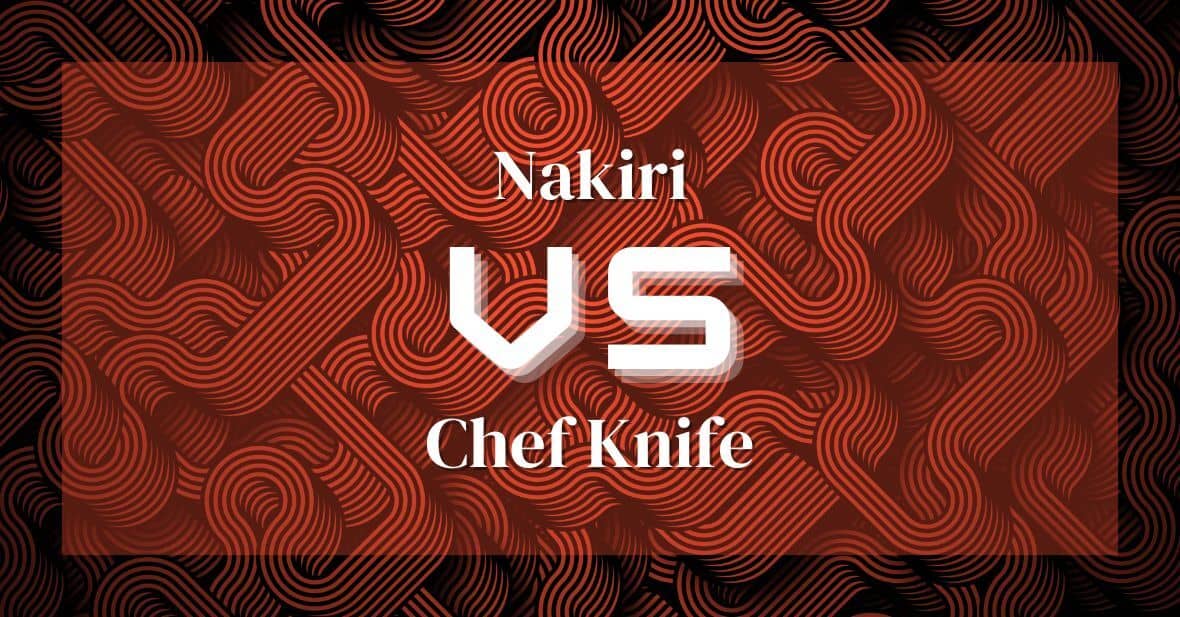Nakiri vs Chef Knife: Dicing and Slicing Face-Off
Hey there! Are you ready to learn about all the differences between a Nakiri and a chef knife? Well, look no further because in this article we’ll be discussing exactly that.
We’ll cover blade shape, length, edge angle, handle design and maintenance and care so you can make an informed decision when choosing the right knife for your kitchen needs.
So let’s get started by talking about blade shape – it’s one of the most important aspects of any knife!
Blade Shape
You might be wondering what the difference is between the two blade shapes! To start, nakiri knives have a flat and rectangular shape that allows for efficient chopping styles. This makes it perfect for slicing vegetables and herbs with ease.
On the other hand, chef knives are slightly curved and more versatile in terms of use. They are able to handle different tasks such as mincing, dicing, slicing, and even cutting through bones too!
Both blades will require sharpening techniques to keep them in top condition, but due to their individual shapes, they should be sharpened differently for best results.
Blade Length
When it comes to blade length, you’ve got two options – longer or shorter. If you’re looking for a more precise cut, then the nakiri is your best bet with its long and thin blade. It’s perfect for slicing vegetables as it allows for more control and accuracy while cutting.
On the other hand, the chef knife has a shorter and wider blade which makes chopping quicker but less precise. When sharpening either of these knives, it’s important to consider the type of steel used in its construction. Harder steels will require more frequent sharpening than softer ones, so if you want lower maintenance blades opt for softer steel types.
Edge Angle
Choosing the right edge angle for your knife can make a big difference in how easily it cuts through different foods. But when deciding between a nakiri and chef knife, you’ll find that the two knives offer different sharpness comparisons and price points – making it hard to determine which is better suited to your needs.
Nakiris typically have greater sharpness due to their thinner blade and higher edge angle, whereas Chef knives are more durable with an average angle of 15°. Although the nakiri boasts a sharper cut, the lower angle makes them less resistant to wear over time.
On the other hand, Chef knives offer a reasonable balance between sharpness and durability at a slightly higher price tag than nakiris. Ultimately, it’s up to you to decide which knife will best meet your culinary needs!
Handle Design
No matter which blade you choose, the handle design can make all the difference in how comfortable and effective your knife feels in your hand. For example, a handle with an ergonomic shape and a textured grip will provide better control over the blade than one with a smooth finish. Additionally, weight balance is key when considering the design of the handle. If it’s too heavy in one area, it could cause fatigue while cutting or chopping.
On the other hand (pun intended!), if it’s too light, you won’t have as much control over your knife movements. Lastly, grip comfort should be taken into consideration – if you don’t feel comfortable holding your knife, then chances are you won’t be able to use it effectively either!
In conclusion, there are many factors that go into choosing between a nakiri vs chef knife – including edge angle and handle design – so make sure to take them all into consideration before making a decision! Here’s just some of what to look for:
- Ergonomic shape
- Textured grip
- Weight balance
- Grip comfort
- Edge sharpness and durability.
Maintenance and Care
Caring for your knife is just as important as choosing the right one – after all, it’s an investment in your cooking experience! Make sure to keep it clean and sharp, and you’ll be slicing and dicing like a pro in no time. Whether you have a nakiri or chef knife, there are some basic maintenance tips that will help you get the most out of your blade.
| Sharpening Techniques | Cutting Motion |
|---|---|
| Whetstone | Push-cut |
| Honing Rod | Rock-cut |
| Electric Sharpener | Pull-cut |
Sharpening techniques such as using a whetstone or honing rod can help maintain the edge of your blade while cutting motions like push-cuts, rock-cuts, and pull-cuts can help ensure that you’re getting the most out of each slice. With proper care and maintenance, both nakiri knives and chef knives can last for years with minimal effort on your part. So don’t forget to take good care of them – they’ll thank you later!
Conclusion
You can’t go wrong with either the nakiri or chef knife. It all comes down to personal preference and what you want to use it for.
The nakiri is great for chopping vegetables, while the chef’s knife is perfect for slicing meats. Both knives feature unique blade shapes, lengths, edge angles, and handle designs that make them ergonomic and easy to use.
With proper maintenance and care, they’ll both last a lifetime – an ever-present reminder of your culinary journey. Whether you’re preparing complex dishes in a restaurant kitchen or making simple meals at home, these tools will always be there to guide you like a trusted friend.
Aiding you in creating delicious cuisine that tantalizes the taste buds and satisfies the soul.
Frequently Asked Questions
What Is The Best Knife To Use For Chopping Vegetables?
Chopping vegetables can be daunting, but with the right knife, it doesn’t have to be! The best knife for the job is a nakiri, a Japanese-style blade with a flat edge that’s perfect for chopping and mincing veggies. Its unique shape also allows for precise cuts without worrying about your fingers getting in the way.
So if you want to make quick work of those veggies, grab yourself a nakiri and get chopping!
What Is The Difference Between A Nakiri Knife And A Chef Knife?
Are you trying to decide between buying a nakiri knife and a chef knife? Well, look no further!
Both are great choices for chopping vegetables, but they have their differences. The nakiri knife is rectangular with two flat grinding blades, making it perfect for slicing and dicing all types of vegetables.
On the other hand, the chef knife has a blade balance that is well suited for larger fruits and vegetables as well as mincing herbs and chopping onions.
So whether you’re prepping a simple salad or preparing an extravagant meal, either one of these knives will make your life in the kitchen much easier!
Can A Nakiri Knife Be Used For Other Tasks Besides Chopping Vegetables?
Yes, a nakiri knife can be used for tasks other than chopping vegetables! It’s perfect for grating cheese and dicing onions, thanks to its flat blade. You’ll love its sharpness and smooth handles, which make cutting an effortless task. The shape of the nakiri knife is sure to bring a smile to your face – you won’t be able to resist making jokes about how much easier your cooking prep will be with this handy kitchen tool.
Whether you’re looking for an extra hand in the kitchen or just want something fun to show off, a nakiri knife is definitely worth considering.
What Is The Most Comfortable Handle Design For A Nakiri Knife?
When it comes to comfort, the handle design of a nakiri knife is key. It’s important to look for one that fits your hand size and shape well, with a smooth surface that won’t cause blisters or fatigue over time.
Additionally, consider the grinding technique used on the blade, as well as its shape; both can help make cutting vegetables more comfortable and smoother.
Ultimately, when you find the right combination of handle design and blade features that work for you, you’ll be chopping away in comfort!
How Often Should A Nakiri Knife Be Sharpened?
Sharpening your nakiri knife is an essential part of keeping it in top condition. Depending on how often you use it and the cutting techniques you employ, honing your blade every few weeks or months can help maintain its sharpness.
To get the most out of your nakiri knife, make sure to sharpen it regularly with a honing steel or whetstone. Doing so will ensure that each cut is precise and effortless, while also preventing any accidental slips or cuts.
Plus, with regular sharpening, you’ll be able to enjoy the full potential of your nakiri knife for years to come!
Additional Resources
19 Types of Kitchen Knives & Their Uses
Western Style Knives 101 | A Comprehensive Introduction to the Basics
The Art of the Slice: A Dive into Japanese Knife Types
What Is a Nakiri Knife Used For? Unlock the Secret to Flawless Vegetable Prep
Nakiri vs Chef Knife: Dicing and Slicing Face-Off
Forging Culinary Excellence: The Best Steel For Kitchen Knives

